February 12, 2004
The Flamingo Watch – Open from 8pm to 6am

Waking up to the sounds and smells of lunch, the day has just begun for those of us on the ‘Flamingo Watch’. Aptly named after a flock of flying pink flamingos that appear only after dark, once all the scientists are tucked up in their bunks, we watch the Rabbit Cam hoping it’s way across the seabed, monitoring it’s vital parameters.
 The first captured image of the famous Flamingo Flock in
the Computer Lab on R/V Atlantis.
The first captured image of the famous Flamingo Flock in
the Computer Lab on R/V Atlantis.
As
Alvin appears on the surface late in the afternoon, full of goodies for
the science party, we gather our data points, ready for another night
of camera tows. The Flamingo Watch is busy making maps, choosing way-points
and deciding on where to take samples, while the rocks brought up by Alvin
are being cataloged and put to bed.
The day crew has prepared the rock cores, covering them with wax and loading
them into the winches. As the beautiful sun sets across the Pacific, Dan
Fornari prepares the Rabbit Cam for it’s overnight seabed visit.
The batteries are charged, magnetometer set to go, the CTD is ready and
the digital camera is attached. A sudden gathering of people on the starboard
deck send the Rabbit Cam on it’s way, with it’s wax cores
ready to pick up pieces of glassy lava for chemical analysis back on land.
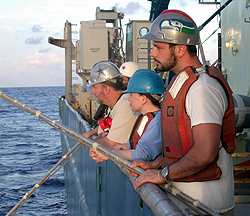
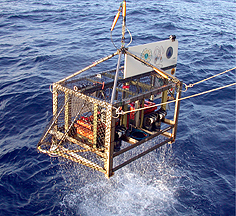
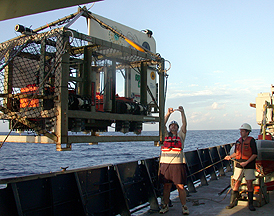
Early risers, Dave Sims (far left), the Shipboard Technician, and Ryan Perfit, join Flamingo Watch members, Rhian Waller and Javier Escartin, to assist with the 6AM Rabbit Cam recovery. Dave directs the launches and recoveries of all scientific equipment on Atlantis.
As the bleary eyed science party make their way below decks, the Rabbit Cam slowly drops to the seafloor for another night taking photos. The Flamingo watch is well underway, with the camera cruising 5 meters above the bottom. Between 8 and 12 visitors gather with welcome cups of coffee, cookies and other entertainment. After midnight, when the flamingos fly, the shift is left alone until sunrise.
Now on Camera Tow #12, the entire CD collection on the RV Atlantis has been listened to, three bags of coffee have been emptied, and there are only two bars of French chocolate left. The flock of flamingos are going wild without caffeine and have even raided Dr. Fornari’s cheese store.
As the night turns into the early hours of day the Rabbit Cam has moved along it’s line taking digital images, magnetometer data and rock cores along the way. When we can see that the camera stops taking pictures, usually around 5am, we know it’s time to bring it home to recover the wealth of scientific data held within it’s hard drives. Hauling in on the wire, the camera is slowly brought to the surface as day breaks across another beautiful sky. The Flamingos begin to flee to their daytime hiding places, and the science party awakes. The Rabbit Cam is brought on deck, the wax balls with glassy basalt samples stuck to them are taken away by the day crew and the camera is washed and tucked up under a blue tarpaulin. The images are downloaded and scrutinized by the now waking scientists, looking for pillow mounds and sheet flows, and even signs of life.
Now at the end of this tenth night we will have recovered 66 glass samples from the seafloor, taken 18,583 pictures along more than 60 miles, and accumulated magnetic and bathymetric information along the way. Data that will give us information on how lava flows away from the axis and piles up to form the oceanic crust. Eleven flights down and seven more to go. Go flamingos!
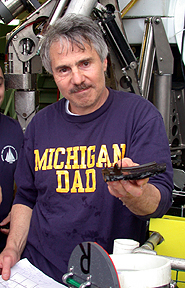 _
_
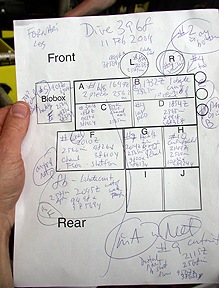
Dan Fornari displays one of the delicate lava "drip" samples recovered on the Alvin dive yesterday. His 'neatly' prepared "scientific" notes taken while diving are shown at right... All the samples were accounted for.
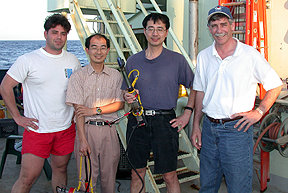 (from
left) Dionusios Foustoukos, Canjun Yang, Kang Ding, and Bill Seyfried
pose with one of their remote vent fluid chemical sensors. This sensor
was recovered after several days in a black smoker vent where it recorded
the chemistry of the fluids that were more than 370°C.
(from
left) Dionusios Foustoukos, Canjun Yang, Kang Ding, and Bill Seyfried
pose with one of their remote vent fluid chemical sensors. This sensor
was recovered after several days in a black smoker vent where it recorded
the chemistry of the fluids that were more than 370°C.
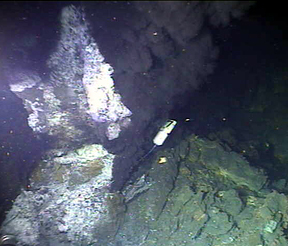
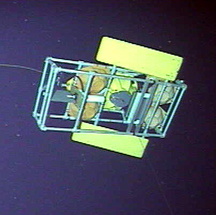
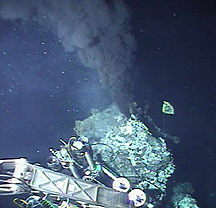
Left photo shows the 'HOBO' temperature logger deployed at P Vent today during Dive 3969. The PIT - Anthony Berry, did a great job at piloting Alvin. He deployed sensors at hot vents, released the steerable elevator from its mooring so it could surface (center), and took water samples from Q Vent (right photo).
 These
stunning images were made by Yuri Rzhanov, our imaging specialist from
the Univ. of New Hampshire. Yuri has been quitely working in the background
using his insight and excellent software tools to manipulate the imagery
from the Alvin dives to give us new insights and perspectives on the seafloor
volcanic terrain on the East Pacific Rise. The image shows a series of
flow fronts which are the ends of the lava flows that have erupted in
the Axial Trough. Note the contact between the pillowy lava about 1/3
the way up the slope and the underlying lobate lava that extends to the
lower right of the photo.
These
stunning images were made by Yuri Rzhanov, our imaging specialist from
the Univ. of New Hampshire. Yuri has been quitely working in the background
using his insight and excellent software tools to manipulate the imagery
from the Alvin dives to give us new insights and perspectives on the seafloor
volcanic terrain on the East Pacific Rise. The image shows a series of
flow fronts which are the ends of the lava flows that have erupted in
the Axial Trough. Note the contact between the pillowy lava about 1/3
the way up the slope and the underlying lobate lava that extends to the
lower right of the photo.
 Lobate
lava flows at ~ 2600 m depth on the crest of the East Pacific Rise.
Lobate
lava flows at ~ 2600 m depth on the crest of the East Pacific Rise.
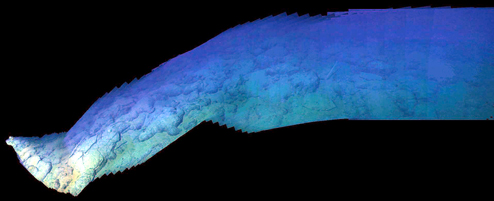
A panoramic view of lobate lava flows as seen from Alvin.
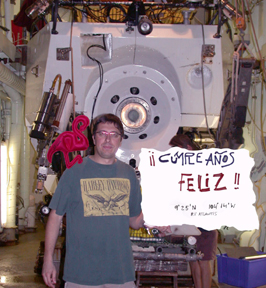
Javier Escartin sends his Birthday Wishes and Love to his Father, Estaban.